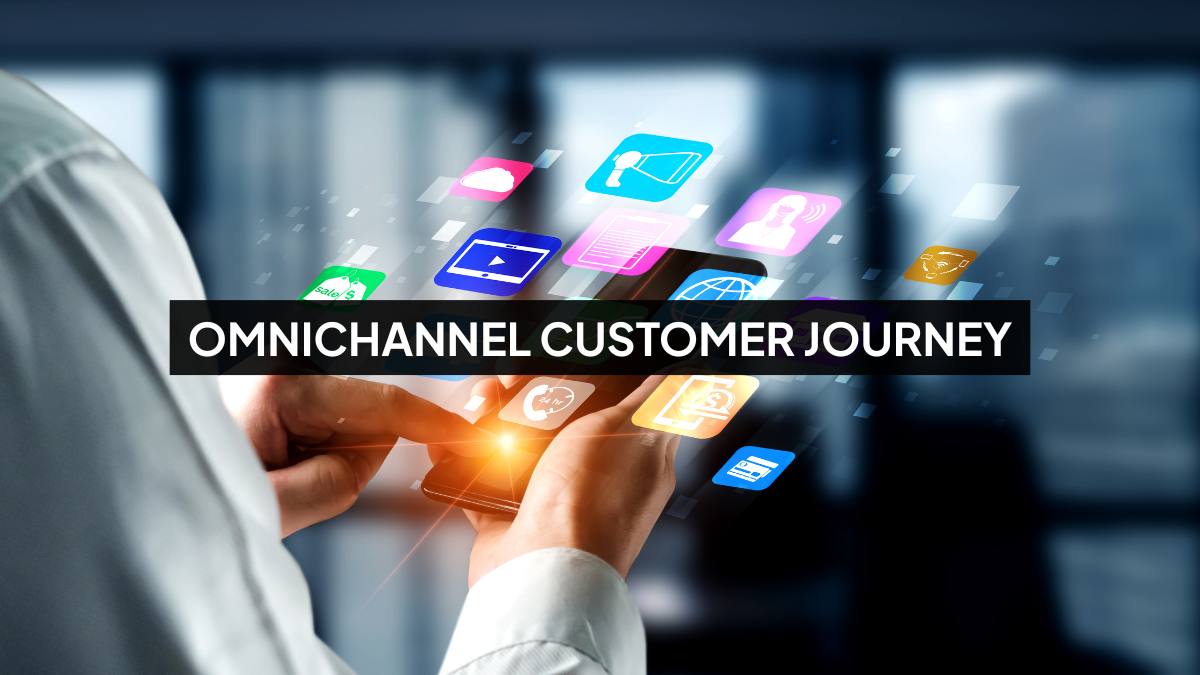You know that feeling when a brand just gets you?
You’re scrolling Instagram and see a product ad that actually speaks to your taste. You click through to the website, where your size is already highlighted. Later, you get an email reminder, not spammy, just helpful. A few days go by, and when you walk into their store, a sales rep already knows what you were looking at online. It’s like magic… except it’s not.
It’s the omnichannel customer journey at work, one of the biggest drivers of brand loyalty, repeat sales, and seamless experiences in 2025.
This isn’t just about being present on every platform. It’s about weaving all those channels into one smooth, connected path for your customer. In a world where attention is scattered and expectations are sky-high, businesses that master this journey aren’t just surviving, they’re dominating.
Let’s unpack how it works, and how you can build one that actually delivers.
Table of Contents
What’s an Omnichannel Customer Journey (Really)?
No buzzwords here. It’s just the path someone takes when they interact with your brand, from seeing an ad to asking a question to making a purchase. Online, offline, wherever. What makes it “omnichannel” is that everything connects. No dead ends. No starting over.
Let’s say someone checks out a product on your app. Later, they open an email about it on their laptop. Then they message you on Instagram with a question. If your brand is doing omnichannel right, all those moments feel connected, like one ongoing conversation, not random one-offs.
Multichannel vs. Omnichannel: What’s the Difference?
People mix these up all the time.
Multichannel means you’re on different platforms, social, email, web, store, whatever, but they all do their own thing. Nothing’s really connected.
Omnichannel means those platforms talk to each other. If someone clicked an ad, your email shouldn’t treat them like a stranger. If they chatted with support, your sales team should know.
Think of multichannel as five people shouting at once. Omnichannel is one person, calmly having a conversation.
Why it Matters More Than Ever
People expect brands to be smart now. If they have to repeat themselves, search for the same product twice, or get hit with a “You forgot something in your cart” message when they already bought it… they’re gone.
Attention is short. Expectations are high. Brands that remove the friction win. The ones that don’t? They get left behind.
Also Read: How to create an Omnichannel Marketing Strategy
Why You Need an Omnichannel Strategy (Like, Yesterday)
This isn’t just a marketing trend. When the experience works, it shows, in your numbers and in how people feel about you.
1. It Feels Seamless
People switch between devices all day, mobile, laptop, tablet. They might see an ad in the morning and finish their purchase at night. If the experience picks up right where they left off? That’s a win.
2. It Keeps People Coming Back
When someone feels like your brand “knows” them, their preferences, what they looked at, when they like to shop, it builds trust. And trust leads to loyalty.
3. It Makes You Look Put-Together
A brand that’s consistent everywhere, same tone, same style, same message, feels more legit. Whether it’s a tweet, a chatbot, or your packaging, it should all feel like it came from the same place.
4. It Drives Sales (For Real)
A smooth experience makes decisions easier. No hiccups. No second-guessing. Just buy, done. And over time, customers who have that kind of experience tend to spend more and stick around longer.
What Makes a Great Omnichannel Experience
Here’s what actually matters. Not trends, not buzzwords, just the basics that work.
1. Keep Your Brand Consistent
From your Instagram captions to your customer support emails to what your in-store staff says, it should all feel like you. Not five different brands pretending to be one.
2. Personalize, But Don’t Be Creepy
Use what you know, like what someone browsed or bought, to make their experience smoother. Recommend something useful. Send a reminder that makes sense. Just don’t overdo it and make people feel watched.
3. Get Your Tech in Sync
If your CRM doesn’t talk to your chatbot, or your email platform doesn’t know what’s in your inventory, you’re going to have problems. The tools don’t need to be fancy, they just need to connect.
4. Respond in Real Time
If someone leaves something in their cart or gets stuck on a page, timing matters. A quick nudge, a helpful message, or even a chatbot popping up can make the difference between a sale and a bounce.
5. Everyone Needs the Same Customer Info
Your support team, marketing team, and sales team should all be working off the same customer view. If one person sees a customer as “new” and another sees them as a VIP, it’s going to be messy.
How to Actually Build an Omnichannel Customer Journey Map
Let’s not overcomplicate this. A customer journey map is just a way to understand how people go from hearing about your brand to becoming a customer (and hopefully, coming back). It’s not some fancy diagram unless you want it to be. It’s about seeing things from their side.
Here’s how you can build one, step by step:
1. Know Who You’re Talking To
Before anything else, figure out who your customers actually are.
Are they college students who live on their phones? Busy parents shopping late at night? Small business owners looking for quick info?
You can’t map a journey if you don’t know who’s on it.
2. List Every Place They Interact With You
This is where people miss stuff.
It’s not just your website. Think: Instagram DMs, Google reviews, WhatsApp, customer support calls, store visits, product packaging… all of it.
Every little moment counts.
3. Ask Real Customers What’s Happening
Don’t assume. Talk to them. Send out a quick survey. Ask your support team what complaints come up the most.
Even a 10-minute call with a few loyal customers can reveal more than a month of analytics sometimes.
4. Sketch Out the Current Journey
What’s the first thing they do? Where do they usually drop off?
You don’t need a fancy tool. A whiteboard, Google Doc, or sticky notes work fine.
Map it out from first touch to conversion, and maybe beyond (like support or loyalty).
5. Find What’s Broken
Look for clunky moments.
Do people abandon their cart on mobile but convert on desktop?
Are you emailing them offers for stuff they already bought?
That’s the stuff that turns people off. Highlight it.
6. Fix the Gaps (But Start Small)
Now think about how to make things smoother. Maybe it’s a welcome email. Maybe it’s syncing your CRM with your chatbot.
You don’t need to overhaul everything at once, small wins add up.
7. Keep Updating
People change. Platforms change.
Revisit your journey map every few months, or when you launch something new.
What worked a year ago might not work now.
What to Track (Without Getting Lost in Data)
You don’t need to be a data scientist. Just keep an eye on the things that actually tell you if your customer journey is working.
1. Customer Retention
Are people sticking around or disappearing after one interaction?
Loyalty is a big sign your experience is working.
2. How Many Channels People Use
Are people going from Instagram to your site? From email to app?
The more connected their experience feels, the better.
Also Read: Top Marketing Channels
3. Response Time
When someone reaches out, how long do you take to reply?
A fast answer (even if it’s automated) can be the difference between a sale or a bounce.
4. Which Channels Convert
Don’t just blast everywhere. Look at what’s actually working.
Is Instagram driving sales? Is email dead? Use that info to adjust.
5. How They Feel (NPS)
A simple “Would you recommend us?” score can give you insight you won’t get from analytics.
If they’re unhappy, you’ll know. If they’re pumped, they’ll say so.
A Few Tools That Help
- Google Analytics 4 – good for tracking behavior
- Hotjar – shows you where people click, scroll, or get stuck
- HubSpot – good for tying marketing and CRM together
- Mixpanel – especially if you have an app or product
- Adobe Analytics – for big teams or more complex setups
How AI Actually Helps
Let’s be honest, AI can sound like this big, scary, corporate buzzword. But in real life, it’s just a tool. If you use it right, it makes your customer journey smoother. If you overdo it, it can feel robotic. The trick is balance.
Here’s how brands are using it in ways that actually help people:
1. Smarter Recommendations
You know when you browse something once, and then suddenly your feed, inbox, and app all seem to “get” what you’re into?
That’s AI looking at what you do and suggesting stuff you’re likely to care about.
As long as it’s relevant and not pushy, it’s helpful.
2. Instant Help (That’s Not Awful)
AI assistants and bots can answer basic questions fast, like “Where’s my order?” or “Do you ship to Canada?”
Nobody wants to wait on hold for 15 minutes for that stuff.
And if things get too complex, a good system will connect you to a real person fast.
3. Chatbots That Don’t Suck
Old-school bots were painful. The new ones? Much better.
They can follow conversations across platforms. Start on Instagram, follow up via email, then continue on your site, it’s all connected.
And they can be friendly, not robotic, if you write them right.
4. Predicting What People Might Do
AI looks at patterns and can guess what someone’s about to do, like leave their cart or need a reminder.
This lets you send that nudge before they bounce, not after.
5. Reading the Room
Some tools can read tone. So if someone sounds annoyed in a chat, AI can flag it and alert a human.
No need to scroll through every chat transcript, just jump in when it matters.
6. Automating the Boring Stuff
Things like updating CRMs, sending confirmation emails, tagging users, it can all happen in the background.
That means your team has more time to do the real stuff, like helping customers or building better campaigns.

Enroll Now: Advanced Digital Marketing Course
Tools That Actually Power All This
You don’t need 50 tools. Just a few that work well together. Here’s what most brands use (and why):
CRM (Customer Relationship Management)
CRM or Customer Relationship Management Keeps track of your customer conversations, purchases, and activity.
- Salesforce – big, powerful, great for scaling
- HubSpot – easier to use, great for marketing + sales
CDP (Customer Data Platform)
Pulls all your customer info from different places into one clean view.
- Segment – good for startups to enterprise
- Bloomreach – especially strong in ecommerce
Chat & Bots
For helping people in real time or with FAQs.
- Intercom – clean, easy, very popular
- Drift – focused more on lead conversion, but solid support too
Email & SMS
You’ll need automation to send stuff at the right time.
- Klaviyo – great for ecommerce, tracks behavior
- Omnisend – easy for email + SMS combos
Social Media Management
Handles posts, replies, and messages in one place.
- Hootsuite – all-in-one dashboard
- Sprinklr – more enterprise-level, with deep integrations
Use what fits your size and budget. Don’t let tools run the show, use them to make things easier.
Also Read: 35+ AI Tools for Content Creation, Chosen by Experts
Common Mistakes to Avoid (That Most Brands Still Make)
Even with the best tools and intentions, a lot of brands trip up. Here are the big ones to look out for:
1. Treating Channels Like Silos
Your email team shouldn’t be doing one thing while your social team does something totally different. If platforms don’t talk to each other, the customer feels it.
2. Ignoring Mobile Behavior
People browse, buy, and chat on their phones first. If your mobile experience is slow or messy, they’re out.
3. Not Using Real-Time Info
If you’re sending “recommended products” based on last month’s data, that’s already stale. Use what people are doing right now.
4. Forgetting to Train Your Team
It’s not just about tools. Your support, sales, and marketing teams need to know what’s going on and how it all connects. Otherwise, customers get mixed messages.
5. Going Too Heavy on Automation
Yes, automation saves time. But if your entire journey feels robotic, people will check out. Keep the human touch, especially when it counts.
What’s Next for Omnichannel Customer Journeys
This space is moving fast. Like, really fast. What worked two years ago might already feel outdated. Here’s where things seem to be heading, and yeah, some of this might sound futuristic, but it’s already starting to show up.
1. AI Getting Way More Personal
We’re not just talking “Hello [First Name]” anymore. AI is starting to understand context, mood, timing, and even what channel you prefer at what time of day. That means offers, content, and conversations could feel crazy relevant without being creepy.
2. AR and VR Experiences
A few brands (especially in fashion, home, and tech) are already testing this. Try on clothes with your phone camera. Walk through a virtual store. It’s early, but as devices get better, expect this to go mainstream. Especially for younger buyers.
3. Voice Search and Smart Devices
People aren’t just typing, they’re using voice search – asking Alexa, Google Assistant, Siri. If your brand doesn’t show up or respond well in that space, you’re missing a big slice of the pie.
4. Messaging That Adapts on the Fly
Imagine sending a gentle reminder email or push notification that changes while the person is reading it, based on their current behavior or mood. This is already starting with tools that mix sentiment data and real-time triggers. It’s wild, but it’s coming.
5. Privacy-First, But Still Personalized
With more rules around data (and more people caring), brands are being pushed to personalize without being invasive. That means using first-party data, giving users more control, and being transparent. It’s not about knowing everything, it’s about using what you do know well.
Wrapping It Up
If there’s one thing to take away, it’s this: customers don’t think in “channels.” They just want a smooth, helpful experience wherever they are. Whether they’re clicking through a story, browsing your site, chatting with support, or walking into your store, it should all feel like one continuous conversation.
An omnichannel customer journey isn’t about being fancy. It’s about making it easier for people to trust you, buy from you, and come back. That’s what drives growth.
And no, you don’t need to do everything all at once. Start small. Fix the friction. Connect the dots.
In 2025, the brands that win will be the ones who think like customers, move fast, stay flexible, and keep showing up in the right places at the right time.
FAQs: Omnichannel Customer Journey
Q: What is the main goal of an omnichannel customer journey?
To make the experience feel smooth and connected, so the customer doesn’t have to start over every time they switch channels.
Q: How is omnichannel different from multichannel?
Multichannel is being on many platforms. Omnichannel connects those platforms so they work together like one system, not separate islands.
Q: What tools help manage omnichannel journeys effectively?
CRMs, CDPs, chatbots, and analytics tools. Think HubSpot, Segment, Intercom, Google Analytics. They help keep data, messaging, and touchpoints aligned.
Q: Can small businesses implement an omnichannel strategy?
Yes, 100%. You don’t need big budgets, just the right tools and a clear focus on customer experience across a few key channels.
Q: What role does AI play in improving customer journeys?
AI helps personalize, automate, and speed things up. It can suggest the right product, flag issues, and help customers faster, without feeling too robotic.
Q: How often should you update your customer journey map?
Every few months is a good rule, especially if something big changes like a new product, channel, or shift in customer behavior.

